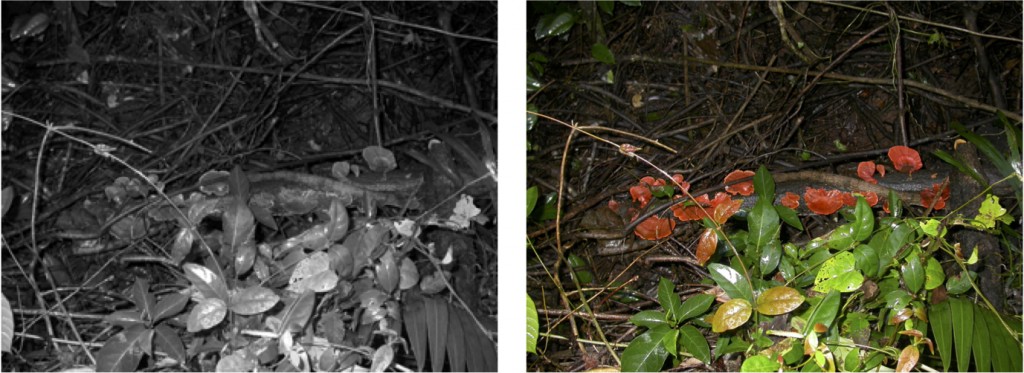“If there are states of sensing bluely, they obviously do not present themselves as such—otherwise the very existence of a controversy about their existence would be inexplicable.” Sellars (1981, 67)
It’s time to get down to the nitty gritty. In the first of these posts I suggested that we look to vision science to motivate some version of colour relationism, and in the second I argued that we should stop thinking of chromatic vision as merely colouring in our perceptual world, but as a means of detecting and discriminating a range of object properties. So what should we now say about colour ontology?
In the book a propose an account whereby colours are properties not of objects, nor of perceivers, but of the perceptual interactions that relate these two. It is a kind of adverbialism because colours are attributed not to things but to an activity (perceiving). For example, instead of saying that the distant mountains are blue, the adverbialist opts to say that they are seen in a blue way—seen bluely. Now the point of my proposal is not to encourage people to replace ordinary English with these awkward adverbial rephrasings. Rather, it is to capture the insight of the recent experimental work on the interaction between chromatic vision and other visual processes. The important lesson was that seeing in colour reveals a world of things around us, regardless of whether or not those things bear a physical or mind-independent property that corresponds to our chromatic experiences.
The basic idea is that colours are both, and at the same time, ways that visual stimuli appear to us and ways that we perceive those things. Take the fungi in these photographs. The availability of colour makes their presence much more vivid—their contrast against the forest background appears to us in this orangey way.
Adverbial analyses of perceptual states were first developed in the mid-twentieth century as an alternative to the then dominant sense-data theories of perception. By the late 1980’s a couple of objections to adverbialism were considered deadly enough to have killed off the whole idea. Wilfrid Sellars is one philosopher who toyed with adverbialism at various points during his career. In a late work, the Carus Lectures, he floats an adverbialist solution to the problem of how we fit conscious sensory events into the apparently non-mental world of neurobiology. The crucial difference between Sellars’ proposal and mine is that he takes colours to be properties of sensing events which are entirely internal to the brain of the individual subject, whereas I extend the process to which we attribute colour outside to include the object perceived.
Like Sellars, I end up with an account which is puzzling and revisionary from the perspective of ordinary language and common philosophical interpretations of visual experience. Sellars was unruffled, writing:
“To put it bluntly, the fruits of painstaking theory construction in the psychology and neuro-physiology of sense perception cannot be anticipated by screwing up one’s mental eye (the eye of the child within us) and “seeing” the very manner-of-sensing-ness of a volume of red.” (1981, 19)
I didn’t think that my readers would let me off so easily, so I devoted the last two chapters of Outside Color to dealing with objections stemming from orthodox ideas about visual experience and the common analysis of perceptual states as representational ones.
Still, I don’t suppose I will have disarmed all that many of the likely objections to colour adverbialism. I take heart from these word from the great Sudanese artist, Ibrahim El-Salahi, whose piece The Tree is the cover image of my book:
“I keep working on one particular theme inspired by a tree, an acacia locally called the Haraz that grows on the banks of the Nile. During the rainy season the tree is leafless, and it blossoms with freshly budding green leaves when the weather turns dry and the river flows at its lowest towards the sea. …..This is a definitive statement. Like saying ‘I am me! I am an individual! I do not follow what everyone is doing! When everyone is going to be green, let them be green. I am not!’.”
Reference:
Sellars, W. (1981). Foundations for a metaphysics of pure process. The Monist 64(1), 3–90.
Feature image: Haraz tree / Faidherbia Albida



It’s quotes like these that make me love Sellars.
The use of adverbs like “bluely” is certainly awkward, but the use of adverbial phrases seems quite orthodox in describing object colour perception. For example in the checker shadow illusion, we see A as a dark surface under high illumination and see B as a light valued surface under low illumination. In your photo of mountains I might see the areas tagged by my visual system with a blue opponent signal as blue mountains or as dark mountains seen through a blue atmosphere. How does “adverbialism” differ from “unconscious inference”?
Hi there — I present adverbialism as a theory of colour ontology — what kind of properties colours are, whereas the theory of unconscious inference concerns the mechanisms or processing steps which lead up to perceptual states. So it’d be really interesting to think more about whether adverbialism has implications for what the mechanisms of perception are.
Thanks Mazvilta, what I meant by my comment was just an observation that the idea that object colours are “ways of seeing” parts of the visual field seems to me to be implicit in the notion of “unconscious inference”, and that the use of adverbial expressions to describe such colours is commonplace. Clearly I’ll need to read your book to understand what adverbialism is and what’s new about it!